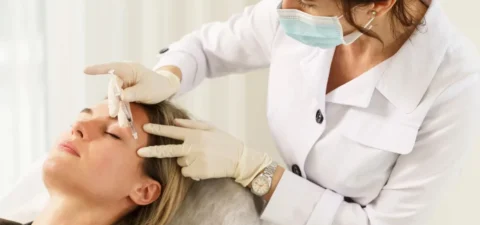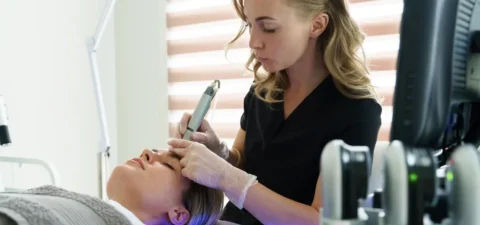For information only. Not meant as advice in any form. Please consult your medical professional or lawyer.
Being a licensed esthetician in Texas means going big or going home because of the competition between thousands of other estheticians and practices with a solid record in providing quality and advanced esthetic treatments. But if you’re still interested in an esthetics career in Texas, you need to be well-prepared with the right training.
So what do you need to do to become an esthetician in Texas? The first thing to do is to organize all the requirements needed to attend an esthetician school. Attend all the classes and complete the course before applying for an esthetician specialty license. Then, pass all the examinations needed for the licensure before pursuing certifications and other opportunities in the beauty industry. Lastly, you should renew the esthetician license in Texas every 2 years.
Becoming an Esthetician in Texas: A Brief Guide
Estheticians help their clients become their most beautiful selves through massage therapy and skin care treatments like waxing, makeup application, facial, and more. The beauty industry is a highly competitive one so the salary rates and work opportunities are different depending on the state you want to practice in.
As a center for healthcare and medical research, Texas offers a lot of opportunities for aspiring estheticians. If you’re also interested in working as a licensed esthetician or skin care specialist in Texas, here’s a step-by-step guide to starting an esthetics career:
1) Prepare for the Education Requirements
Before becoming an esthetician in Texas, the applicant should enter a cosmetology school first and complete their esthetics program. Different schools have different requirements, so make sure to check with the chosen school first before enrolling.
According to the Texas Department of Licensing and Regulation, a high school diploma or equivalency is needed to apply for a cosmetology license in Texas. If the applicant doesn’t have a diploma or equivalency, they may take an “ability-to-benefit” test given by a certified testing agency. This examination measures the applicant’s ability to benefit from the training they’re applying to.
2) Complete a Training Program in Esthetics
The next step is to complete a Commission-approved esthetician training program for at least 750 training hours. The approved esthetician program should also have theoretical and clinical training where aspiring estheticians learn everything they need to know about their chosen career path, including safety and sanitation.
The curriculum for esthetician training varies per beauty school, but it should at least include topics like:
- Aromatherapy
- Chemistry, anatomy, and physiology
- Client care
- Color psychology
- Equipment and electricity
- Cleansing, masking, and facial treatment
- Makeup application
- Management
- Nutrition
- Rules and law
- Safety, sanitation, and first aid
- Superfluous hair removal
How to Pick the Best Esthetician School
The first thing to consider when picking a career school is its accreditation or approval. Aside from being recommended by the state of Texas, some of the best esthetician schools are also accredited by the National Accrediting Commission of Career Arts and Sciences. Make sure to research the school and review their training program to see if it’s the best one for your goals.
To help you get started, here are some of the best esthetician schools to consider in Texas:
- Aveda Institute
- Houston Training School
- Texas College of Cosmetology
- North Central Texas College
- Baldwin Beauty School
- Ogle School of Hair, Skin, and Nails
- Champion Beauty College, Inc.
- Howard College
- Vogue College of Cosmetology
3) Apply for Esthetician Specialty License
After completing the esthetics training program, the next step is to apply for licensure. Do this by completing the Cosmetology License by Examination (where applicants can choose their specialty) and submitting it to the state board. Applicants are also required to pay a $50 application fee to the Texas Department of Licensing and Regulation (TDLR).
The TDLR works with PSI Testing Services to conduct esthetician licensure examinations. Once the applicant’s entry has been received and approved, their eligibility will be confirmed by the TDLR through an email. The email also includes the scheduling and other important information about the licensure examinations.
4) Pass the Written and Practical Exams
Taking the written examination costs $55, while the cost of the practical examination is $78. Applicants are required to pass the written exam first before they can move to the practical exam.
a) Preparing for the Exam
Applicants can prepare for the exam using different reference materials they used during their esthetics school, but the National-Interstate Council of State Boards of Cosmetology (NIC) also recommends the following materials to help applicants prepare for their written and practical exams:
- Milady Standard Esthetics: Fundamental
- Salon Fundamentals: Esthetics Textbook
b) What to Bring During the Exam
Candidates are advised to arrive about 30 minutes early at their testing site for the check-in procedures. They’re also required to wear close-toed shoes or they won’t be admitted into the exam center. If this happens or they’re late, they need to reschedule and pay for the exam fees again. Here’s a list of the things that applicants need to bring to their exam schedule:
- Proper identification
- A model (for the practical exam)
- Testing kit (for the practical exam)
c) Exam Outlines
The written examination for estheticians in Texas consists of the following assessment areas:
- Sanitation, disinfection, and safety (for 35%)
- Client consultation and analysis (for 12%)
- Basic facial treatments (for 20%)
- Advanced facial treatments (for 12%)
- Hair removal (for 9%)
- Facial makeup (for 5%)
- Licensing and regulation (for 7%)
On the other hand, the practical examination for estheticians in Texas consists of the following assessment areas:
- Pre-exam setup and disinfection (for 10 minutes)
- Skin cleansing service (for 15 minutes)
- Face and neck steaming (for 5 minutes)
- Mask/pack moisturizing (for 15 minutes)
- Eyebrow arching with tweezers (for 10 minutes)
- Eyebrow arching with mock cold wax (for 10 minutes)
- End of exam disinfection (for 10 minutes)
5) Apply for Esthetician Jobs
After passing the licensure examination for estheticians, the next smart thing to do is to apply to other practices as an esthetician, makeup artist, or skincare specialist. This allows aspiring estheticians to learn alongside experts in the industry and pick up a technique or two that they can use in the future. There are plenty of work opportunities for estheticians in Texas, so your pick will be entirely up to you.
Estheticians in Texas can earn as much as $27.77 per hour, which is close to the national average. A medical esthetician and other estheticians who manage their practice can earn more, but it all depends on having a loyal customer base.
6) Enroll in Specialty Certificate Programs
Having a certificate in specific skin treatments isn’t part of the job description as an esthetician, but it gives the applicant a competitive edge over others who are applying for the same position. There are plenty of specialty certificates to choose from, but here are some of the most popular ones:
- Eyelash extensions (required training time: 320 hours)
- Hair braiding (required training time: 35 hours)
- Hair weaving (required training time: 300 hours)
- Wig (required training time: 300 hours)
7) Maintain Your Esthetician License
Like other professions, licensed estheticians should undergo continuing education and renew their licenses now and then. In Texas, estheticians must renew their license every 2 years based on the date they received their license.
To be qualified for license renewal, the esthetician must complete an hour of continuing education in sanitation and at least 3 hours of other topics related to esthetics and cosmetology. They should also complete the renewal process online and pay $50 the renewal fee.
Online Courses for Estheticians at FACE Med Store
Being an esthetician is a promising career for people who want to join the beauty industry by providing clients with skin treatments that enhance their appearance and boost their confidence. Whether you’re a seasoned or aspiring esthetician looking for online training courses to expand your skill set, you can find what you’re looking for here at FACE Med Store.
Aside from our online training courses for beauty and cosmetology, we also supply hundreds of healthcare institutions and medical spas across the US with quality medical tools needed for the treatments they offer. Contact us today to know more about our training programs or beauty and medical supplies for you.






